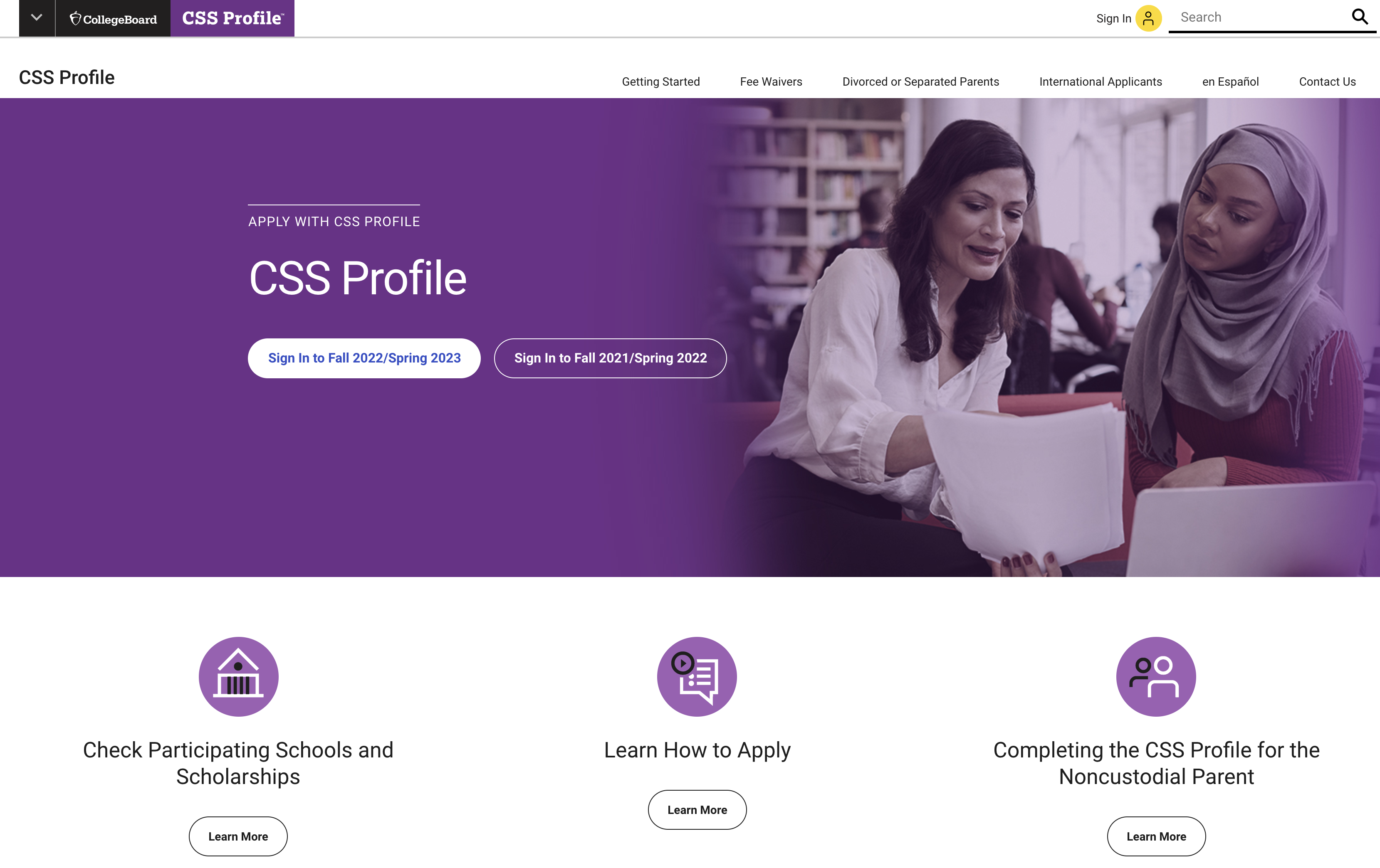CSS Profile Form Required By Highly Selective Colleges.
Elite colleges and universities require parents to file the CSS Profile form in addition to FAFSA. In this article, I’ll review the CSS Profile form and the formulas behind it that drive up the costs.
In fall and winter, I often receive calls from frantic parents who are worried and confused about how to file the CSS Profile. They fear losing financial aid if they don’t file it correctly and provide additional financial information through iDocs. I just heard from one parent who wondered why must they upload their W2 when they already sent copies of their income tax returns? Why must they produce a form 1099 when they have none? They repeatedly must answer “how much can you pay,” as if the family could pay what they want, and “how much can the student pay,” even though the parents already indicated that their child has no income.
Colin’s parents chuckled: “We reported the value of our cars, years and make, boat, motorcycle, and stamp collection passed on to us by grandpa. We thought we were done, but no, there was one more question: “Is there anything else?”
Colin’s parents have considerable income and assets, but still can’t pay a cost of attendance of $79,950 per year. Thus they answered everything, as they must when asking for the college’s own funding. They send the CSS Profile to all four colleges even before they know whether their student is accepted.
CSS Profile stands for College Scholarship Search and implies that colleges can award more than federal aid alone. FAFSA stands for “Free Application for Federal Student Aid.” This family’s expected contribution is nearly $50,000, and will qualify only for federal unsubsidized loans up to the full cost of attendance. If the CSS Profile colleges meet 100% of need, this family demonstrates a need of $30,000, which is the difference between the minimum amount they can pay ($50,000) and the total cost of attendance ($80,000.)
As a professional consultant who has worked in college admissions and financial aid for decades, I can tell that Colin’s parents, two working professionals, must evaluate whether they are able and willing to pay a minimum of $200,000 over four years for their first child, (they have another one, three years younger) or adjust the college list to include less expensive colleges. These parents will decide for themselves. It’s their values. It’s their relationship with love and money.
By working with me, they learned that their minimum contribution is $50,000 based on an assessment of their income and assets. If their child attends the in-state, public institution, they will have more than enough money to pay the costs. But it their child attend the elite universities, they may end up paying more than their $50,000 expected contribution.
Colin’s parents as curious about how their financial situation is being assessed. I showed them the following chart. It shows the formulas behind FAFSA and CSS Profile. Needy families will get more aid at colleges that primarily fill demonstrated financial need, but these colleges are highly selective. Families with high income and assets will pay less at colleges that primarily fill need with merit scholarships.
Comparison between FAFSA and CSS PROFILE
| FAFSA vs. PROFILE
|
FAFSA | PROFILE |
| Which financial aid form do colleges require? | Colleges require the FAFSA to award federal and state aid. These colleges must be accredited and approved to receive Title IV funding. | About 200 schools use the College Board’s CSS Profile to assess demonstrated need and award institutional aid. 85 of these use iDocs.
|
| Timeline for filing | Can be filed as early as October 1 of the student’s senior year of high school, or soon after the student applies for admission. While the U.S. Department of Education keeps the FAFSA processor open until June 30 of the award year, colleges prefer to receive FAFSA as early as possible after October 1 of the student’s senior year. | File beginning on Oct 1 of senior year. It’s important to file by the colleges’ priority deadlines to make sure you don’t miss out on their institutional financial aid. |
| How are parents’ incomes assessed? | Progressive rate from 24% to 47% of AAI Adjusted Available Income | Progressive rate from 24% to 46% of Adjusted Available income |
| How are students assessed?
Note the Income Protection Allowance (IPA) is an exclusion on FAFSA. There’s no IPA in CSSProfile. |
Students have a Personal Income Protection Allowance (IPA) of $6,970 in 2021-22. Students can work and earn up this amount and none of it is included in the student’s Expected Family Contribution – EFC (soon to be called Student Aid Index -SAI.)
The Consolidated Appropriations Act, 2021, will increase dependent students IPA to $9,410 starting in 2023-24. Student’s earnings above the IPA are added to the student’s EFC at the rate of 50%.
|
Students have no Income Protection Allowance. On the contrary, they are required to contribute an amount of roughly $2,500 (varies from college to college and year in school.) Wages in excess of the $2,500 are assessed at the rate of 50% and added to the student’s EFC. |
| At what rate are parents’ assets considered? | 5.64%. | progressive rate from 4% – 5% Institutions can decide. |
| How are students’ assets considered? | 20% | 25% |
| How are the federal and Institutional formulas different? | The portions of Federal Aid, such as the Pell and SEOG grants are entitlements (gifts) that don’t have to be paid back, unless students fail to progress toward a degree. The subsidized Direct loan, veterans’ benefits, Federal Work-Study are subsidies. Students have to find jobs earmarked for work-study to actually earn money. There are no guarantees that these will be available. Loans have to be paid back with interest and fees.
The Federal Formula is public: https://fsapartners.ed.gov/sites/default/files/2021-08/2223EFCFormulaGuide.pdf |
Profile Colleges use institutional formulas and decide internally who they fund and by how much. Some reward merit, others need, yet other colleges award a combo of both merit and need. Students receive different amounts from different institutions.
The Institutional Formula is kept confidential. |
| Cost for filing? | Free | The College Board administers CSS Profile, and each application has a fee. $25 for the first one and $16 for each additional one if filed at the same time. Fee is waived for low-income students. |
| Source of funding? | Federal and state governments | Colleges’ own funds |
| Whose tax forms?
|
Parent with whom the student lives with the most (e.g., 51% of the time) files FAFSA.
The Appropriation and Consolidation Act of 2019-20 changed this. Starting July 1, 2023, the parent who provided more financial support files the FAFSA, regardless of where the student lives. |
Custodial and Non-custodial parent(s) and respective spouses file a CSS Profile. The income and assets of the two biological and step-parents are considered. |
| Which formula considers the equity of the homestead? | FAFSA does not consider home equity of the family’s principal place of residence. (It does ask for value of a second home, whether vacation or rental.) | Profile considers home equity (market value minus what is owed on it. Colleges suggest checking on Zillow to figure market value). Value of second home, cars, trucks, boats and other vehicles, collectibles, etc.) |
| How is business or farm equity assessed?
|
No assessment if a family business or farm employs fewer than 100 employees.
The Appropriation and Consolidation Act of 2019-20 changed this and will be considered and assessed starting on July 1, 2023.) |
Considered in net worth, but not clearly explained publicly, and there is no uniform formula.
|
| Are there required filing methods? | Students and parents are required to verify their tax information by using FAFSA’s Data Retrieval Tool (DRT). This will become automatic in 2023. | No DRT. Parents provide their tax returns for up to three years. Some colleges require parents to transmit info through the College Board service called “iDocs.” |
Excerpt from: How to Control Your College Costs pp. 137-139 https://amzn.to/3t3c19s Amazon ISBN -13:978-1-7362609-2-0 (paperback), 978-1-7362609-1-3 (Kindle)
Which Colleges meet 100% of a student’s demonstrated need without loans? 19. They are the most selective colleges in the country:
- Colby College
- Columbia University
- Davidson College
- Harvard University
- Johns Hopkins
- Massachusetts Institute of Technology (MIT)
- Northwestern University
- Pomona College
- Princeton University
- Stanford University
- Swarthmore College
- University of Chicago
- University of Pennsylvania
- US Air Force Academy
- US Military Academy (West Point)
- US Naval Academy
- Vanderbilt University
- Washington and Lee University
- Yale University
References
CSS Profile Instructions: https://cssprofile.collegeboard.org/getting-started-your-css-profile-application
Institutional Methodology: https://secure-media.collegeboard.org/digitalServices/pdf/professionals/institutional-methodology.pdf
CSS Profile. https://cssprofile.collegeboard.org>getting-started Helpful tips and resources for students and families before they start the CSS Profile Application.
Getting Started – Completing the CSS Profile Form, College Board
Student Guide 2022-23 CSS Profile – https://cssprofile.collegeboard.org/pdf/css-profile-student-guide.pdf
How to Control Your College Costs by C. Claire Law https://amzn.to/3t3c19s (April, 2021) Amazon ISBN -13:978-1-7362609-2-0 (paperback), 978-1-7362609-1-3 (Kindle)
 Students at Harvard Yard Nov 2021
Students at Harvard Yard Nov 2021


